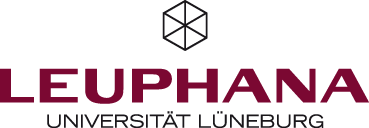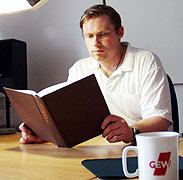Welcome to the archive and the old website of the research area ((audio))
Attention! This website serves as an archive and will not be updated.
New website officially online from 15.9.2019 at llaudioll.de.
'((audio)) Aesthetic Strategies' is a division within the Institute for Culture and Aesthetics of Digital Media (ICAM) at Leuphana University Lüneburg. ICAM ((audio)) is involved in research and teaching 'Music and Auditive Culture' within the Major 'Kulturwissenschaften' (Cultural Sciences) and the Minor 'Digital Media / Culture informatics' of the Leuphana Bachelor of Arts program. The Institute also contributes to the Major 'Culture, Arts and Media' of the Master of Arts program 'Arts & Sciences'.
Research Activities
We explore research questions concerning digital media in the sub-fields of:
- technoculture
- media integration, interfaces, surfaces
- sampling and program control
- data networks as cultural spaces
In addition to the resources available at the computer and media center at Leuphana University, a digital 'audioLab' (electronic studio) provides further opportunities for project work by both students and others in the region. In courses, tutorials, study groups and in cooperation with other institutions we work on theoretical as well as practical problems in the spheres of electronic and digital media.
Objectives
Our overall objective is an advanced command of the methods and techniques in the field of digital media production, as well as a critical reflection of theories of media-cultural change. In addition to regular courses we also offer study groups and tutorials focusing on these main topics. Moreover, we provide one- to two-day workshops cooperating with guest artists/musicians, and also welcome visitors from other universities, cultural organizations, and commercial music production. Both the 'audioLab', as a high-end production facility, and the computer center’s 'workroom digital audio' provide the technological resources for these activities.
Among our activities are the following:
- general working techniques and methods of media production
- basic configuration of MIDI and audio workplaces
- MIDI and audio standards
- periphery control and programming (synthesizer, sampler)
- video synchronization
- inter- and intranet, including HTML integration of MIDI and audio files
- material editing and design
- digitalization and editing of audio material
- sample cutting and looping
- sequencing
- effects (reverb, echo, chorus etc.)
- signal processing, mastering (enhancing, compression etc.)
Communication and Cooperation
Keeping the contents and methods of our research and teaching up-to-date is a matter of particular concern for us. The acquisition of knowledge and practical contexts has changed fundamentally as a result of innovations in hard- and software which are driven by processes of rationalization, optimization, and aesthetic change.
We hold the opinion that academic education should not only be based on a fixed canon of skills and knowledge, but also has to be an organized communication process which reflects both local competence and innovative ability.
From our experience, we believe that the contents and methods we teach are based on inside knowledge that is best acquired in expert conferences and at festivals, as well as in practice with broadcasting corporations, production companies, and artists/musicians. Our research and teaching methods reflect this belief.
With this in mind, we facilitate regional integration by opening the 'audioLab' to regional interest groups. Along with the participation of musicians (e.g. the local techno and house scene), artists, and multimedia producers alike we offer a place for the use of digital audio and AV media. Furthermore, audioLab devices are used in-house at Leuphana University for live performances and workshops organized by invited musicians and artists.
Technoculture: Tool vs. Medium
The relaying of artistic intention into processes of hardware and software development is just as problematic as the relaying of technological potential into artistic imagination. The 'tool' as an artistic medium, already vaguely contains the idea that is realized. We believe that this principle has been implicitly understood by artists working in a traditional way for centuries, but is neglected in the current transition in digital media development because of the wide gap between artistic and technical competence.
We believe that it is the malleability of 'digital tools' that focuses us on the relationship between instrument, composition, and opus. But are these relations and categories applicable at all anymore? This is why a central objective of the project is to convey and reflect perspectives of technoculture in the field of application development.
Related topics are:
- theories on industrialized society / information society
- media theory
- organology / instrumentation / theory of composition with electronic instruments
Media Integration, Surfaces, Interfaces
Multimedia, digital media integration, and the 'surface principle' of machines which process symbols have changed the strategies of medial design.
What needs to be explored is the threefold relation between the technical aspect of integration and interface, the creative aspects of surface, and the cultural aspects of the aesthetic process. At the same time, special attention needs to be paid to the auditory and tactile surfaces that have been neglected in the discussion about visual media.
Especially in the context of teaching, auditory space and incorporated knowledge show that multimedia creates a complex interdependence between human perception and construction of meaning. This happens in a multisensoric and multisemantic sensuous experience. Both in effect establish surfaces for HD recording, sequencing, and audio editing, including the examination of experimental surfaces for music, painting, or interactive installations.
Related topics are:
- development of sequencer surfaces
- digital audio processing, and editing
- video dubbing, and SMPTE synchronization
- construction of simple experimental interfaces (tactile and movement sensor system)
Sampling, Program Controlling
Multimedia standards allow for integration of data and 'documents' into pre-shaped program environments. Standardized system software interfaces (e.g. multimedia APIs), flexible, object-oriented component systems (e.g. MAX, PD), enable qualitative innovations in the field of aesthetic applications once the flashy facades of the multimedia surfaces are discarded.
The aim of creating multimedia programming requires more than the mere application programming with preformed multimedia tools. It also includes the development of proper program components. These components are designed with the shared aesthetic concepts of a team of artists (musicians), technicians, and computer scientists. This also affects the handling of data resources in the aesthetic techniques of collage and montage.
Sampling, in this regard, stands for a specific field of program-controlled access to digitalized media material, which is on the one hand proven in appropriate program environments, and on the other hand reflects aesthetic considerations.
The musical tradition of 'sampling', including those of contemporary genres (e.g. in Hip Hop or Techno), as well as discussions about principles of sampling in contemporary art and literature are part of the discourse at our Institute.
Other related topics are:
- history of sound synthesis and sampling
- musique concrète / electronic music of the 'Cologne School'
- Sampling vs. montage/collage in music, visual arts, and literature
- Sound programming
- interface programming (Borland-Delphi, Basic, MAX, PD)
- current sampling practice in popular music
- samples in multimedia environments
Data Networks as Cultural Spaces
The 'Gibsonian Cyberspace' concept (as Michael Benedikt calls the definitional vision of cyberspace by William Gibson), perceives the world of digital networks as the virtual workplace of the future. In addition to the cyberspace as action space, the vision of interlinked global knowledge, the Docuverse (Bush/Nelson), constitutes a second metaphoric model for the potential of data networks. These are ultimately a global universal resource of access for medial artifacts of all times and spaces. The fact that such literary fictional visions do become part of real technical concept is made clear by the address convention of the world wide web (URL = Uniform Resource Locator). Whether and how a cultural adoption of this 'Turing galaxy' (Wolfgang Coy) took place was determined by technical, economic, and cultural conditions, but also by the participation of various social action systems. Artistic usage is seen both as an indicator and as an experimental site for changed communication and perception structures. With this in mind, the division 'Aesthetic Strategies' looks into the matters of aesthetic production and distribution.
Extending the notion of text (particularly ‘aesthetic texts’), visual arts and music in the tele- and mediamatic environment account for specific text types that are coded as data, transmitted, and transformed.
For the musical arena, the following questions emerge:
- What are technical practices of integrating audio files into online applications?
- How can audio and AV documents be produced cooperatively in networks?
- What are forms of distribution of music in the internet?
Literature
Grossmann, Rolf / Hanácek, Maria (2016): "Sound as Musical Material". In: Papenburg, Jens Geritt / Schulze, Holger (Ed.): Sound as Popular Culture. A Research Companion. Cambridge: MIT press. pp. 53-64.
Grossmann, Rolf (2016): "Phonographic Work". In: Papenburg, Jens Geritt / Schulze, Holger (Ed.): Sound as Popular Culture. A Research Companion. Cambridge: MIT press. pp. 355-366.
Grossmann, Rolf (2008): The tip of the iceberg: Laptop music and the information-technological transformation of music.
In: Organised Sound 13(1): 5–11. Cambridge: University Press



